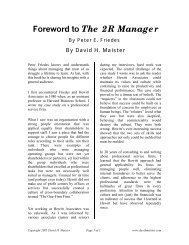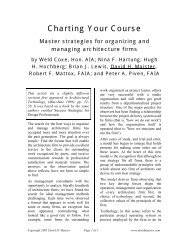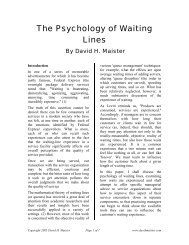pdf version - David Maister
pdf version - David Maister
pdf version - David Maister
Create successful ePaper yourself
Turn your PDF publications into a flip-book with our unique Google optimized e-Paper software.
The Anatomy of a Consulting Firm<br />
that is routinely monitored by firm<br />
management. However, as we have<br />
shown, its role in balancing the firm is<br />
critical.<br />
It is possible, and not uncommon, for the<br />
firm’s project team structure to change<br />
over time. If it is possible to deliver the<br />
firm’s services with a greater proportion<br />
of juniors, this will (in general) reduce<br />
the costs of the project. Competition in<br />
the market for the firm’s services will,<br />
over time, require the firm to seek out<br />
lower costs for projects of a particular<br />
type, and there will often be<br />
opportunities for an increasing<br />
proportion of juniors to be used on<br />
projects that, in the past, required a high<br />
proportion of senior time. What in past<br />
years had the characteristics of a Brain<br />
Surgeon project may, in future years, be<br />
accomplishable as a procedural or<br />
Pharmacy project.<br />
When considering new projects to<br />
undertake, it is usually more profitable<br />
for the firm to engage in one similar to<br />
that recently performed for a previous<br />
client. The knowledge, expertise and<br />
basic approaches to the problem that<br />
were developed (often through<br />
significant personal and financial<br />
investment) can be capitalized upon by<br />
bringing them to bear on a similar or<br />
related problem. Frequently the second<br />
project can be billed out to the client at a<br />
similar (or only slightly lower) cost,<br />
since the client perceives (and receives)<br />
something equally custom-tailored: the<br />
solution to his problem. However, the<br />
savings in costs incurred by the firm in<br />
delivering this customization are not all<br />
shared with the client (if, indeed, any<br />
are). The firm thus makes its most<br />
money by “leading the market”: being<br />
able to sell as a fully customized service<br />
(at a fully customized price) what<br />
increasingly becomes a service with<br />
reproducible, standardized elements.<br />
While it is in the best interests of the<br />
firm that similar or repetitive<br />
engagements be undertaken, this is often<br />
not in accord with the desires of the<br />
individuals involved. Most individuals<br />
that join consulting firms do so out of<br />
the desire for professional challenge and<br />
variety and the avoidance of routine and<br />
repetition. While they may be content to<br />
undertake a similar project for the<br />
second or third time, they will not be for<br />
the fourth or sixth or eighth.<br />
The solution, of course, is to convert the<br />
past experience and expertise of the<br />
individual into the expertise of the firm<br />
by accepting the similar project but<br />
utilizing a greater proportion of juniors<br />
on second- or third-time projects. Apart<br />
from requiring a lesser commitment of<br />
time from the experienced seniors, this<br />
device serves the admirable purpose of<br />
training the juniors.<br />
For all these reasons, we might suspect<br />
that, over time, the proportion of juniors<br />
to seniors required by the firm in a<br />
particular practice area will tend to<br />
increase. If this is allowed to proceed<br />
without corresponding adjustments in<br />
the range of practice areas, the basic<br />
project team structure of the firm will<br />
alter, with significant impacts on the<br />
economics and organization of the firm.<br />
The dangers of failing to monitor the<br />
leverage structure are thus clearly<br />
revealed.<br />
Copyright 2005 <strong>David</strong> H. <strong>Maister</strong> Page 13 of 13 www.davidmaister.com











